Akira Kurosawa – the early War Period films
October 6, 2009
… some off-the-cuff words/academic analysis as part of my current university studies (Cultural Expression in Modern Asia – literature, cinema and popular culture in China, Japan and Indonesia). Not much here on Japanese Textiles per se, but the portrayal of textiles in Kurosawa’s films makes me wonder why I haven’t viewed them till now – kimono, geta, kasuri, hakama, rough-sashikoed judo jackets! …
Akira Kurosawa’s popularity and reputation as an important Japanese film director; some examples of his filmic depiction of Japanese culture
Accolades from the West have made Kurosawa a very important Japanese film director. But for the Japanese themselves, he seems to me to be important for two reasons: his work mirrors the trials and tribulations of several generations, from the ’40s (war and Occupation) to the ’80s (environmental issues). Secondly, despite the different genres he covers (in an industry and for a society for whom the departmentalisation of film genre is all-important), he presents archetypal and epic story-telling. Thirdly, the origins may lie in the West for some screenplays, but their form is Japanese. He certainly tackles ‘big picture narratives, in contrast to the closed world domesticity of Ozu.
This prolific creation over many decades which he creates is not dissimilar to that of pop singer Misora Hibari. In a sense, Miyazaki is an obvious successor: moralistic story-telling for the next generation (still grounded in WW2) with concerns about climate change and the environment, demanding engagement if not social activism. Miyazaki’s anime form is different and the magic realism is at odds with the great cinematic traditions of the previous generation (not only in Japan but also in Europe and America), but a similar over-arching trajectory is still present.
I’ve watched the war period films (affected by Japanese war censors as well as Allied Occupation censors) because nationalism tends to bring out traditional cultural values quite strongly. The films appear to be only available on DVD from China and there is of course much debate about the quality of subtitles, copyright infringement, the current strong anti-Chinese sentiment when it comes to consumer goods like DVDs. I’ve relied heavily on the films’ imagery; the subtitles are not only poor but potentially very misleading – I’m not sure to what extent Japanese women would swear at each, for example, as portrayed in The Most Beautiful.
Sugata Sanshiro (1943)
Culture is expressed through themes of personal struggle against adversity; loyalty to the clan and conflicts between clans; the pursuits of men vs the domestic life of women.
In terms of imagery, undeniably important is the lotus and the struggle (against the enemy, both metaphorical and literal) being based on Buddhist religious faith – going deeper than the Japanese to the Chinese heart of the religion. Another important image is that of torn cloth, the renting of traditional culture embodied in the artefact of handwoven fabric. Torn cloth is associated with vivid turning points in people’s lives – the embarrassment of student, with torn sleeve, meeting master; Siu’s broken geta requiring Saam to offer assistance by tearing cloth to repair the shoe. Set in 1882, much is made of the differentiation between the West and Japan via costume and fabric. Particuarly dramatic is the nexus of Western clothing worn by the lounging suitor of Siu and his ashing his cigarette into the camellia of the flower arrangement. Importantly judo (referred to as karate and kung fu in the subtitles) is very much a bushido-like life-and-death struggle, not the sport/entertainment we associate it with now, a century later. Defeat invariably leads to shame, sickness and death (less dramatic than harikiri or fighting ending in death by samurai sword, but the outcome is the same), something dealt with much more in the sequel.
Kuo’s daughter accommodates the female element in an otherwise all-male world. The scene between hero Saam and love interest Siu outside the Shinto shrine was criticised by war censors as “too American” – is the Female “debilitating”, “weakening”, “distracting” and is there a subtle nexus too of the Female and the (American) enemy, perhaps? The introduction of the female love interest certainly comes across as awkward – the rhythm of interaction between the sexes is more comfortable in the sequel. Given the popularity of Kurosawa is evident in the many re-makes and copies by others, the Hong Kong judo epic Throw Down apparently is very closely based on SS.
Zoku Sanshiro Sugata (1945)
Decried by Kurosawa himself, this is panned universally by critics as his worst film. It’s less an “action” film and with a barely-moving narrative, it seems to be an exposition on the struggle for Japanese traditions to survive and maintain relevance in a modernising Japan. An obvious agendum seems to be standing up to Allied Forces Occupation, from the opening scene involving the bashing up of a young rickshaw driver, through to the formal fist-fights at the Embassy. Focus of the first third of the film is on the Japanese heart of traditional martial arts – pursuing it not for the sake of winning or losing but for continuing the tradition, “being” Japanese (the subtitles refer often to “Japanese Arts” in this respect – in contrast to the barbaric American fist-fighting but also to the ill-mannered rivals of the Station dojo, Tin and Yuen (ghost-hair) Kuo: all in all, a quite long-winded explication on what it is to be Japanese and what way of life to pursue. The nature of managing others, the student-sensei relationship, being an effective leader, the nature of ‘celebrity (popularity and fame drawing enemies and envy) are all there. The last third requires some narrative jump-start and this is provided by the fist fight between Killer and Chee, followed by the clash of the two judo/karate/kungfu styles in the snow. I have no clear idea of what the scene involving Yuen Kuo and a rolled-out bolt of yabane-patterned fabric owned by Siu was all about – I’m guessing any sort of underhand trickery to bring down Saam Chee was rejected out of hand by his colleagues as breaking with convention too much. Hero Chee ends up reversing his philosophical objections to fighting inside the American Embassy – he ends up fighting for money, with the cash dramatically appearing, prop-like in his face from stage left. The Buddhist monk has a stronger presence in this film than the first – the philosophical case for Old Japan being articulated. Since there was more talk than action in this film, I found the subtitles troublesome. There is no decent copy of this film in existence; the stock was of poor quality at the time.
The Most Beautiful (1944)
Values: leadership and “followship”, goal-setting and management style; emancipated women; city vs country; teamwork and common goals, both at the workplace, in their military band and on the volleyball field; personal sacrifice and the hierarchy of personal values – emperor/country/family then self. One commentator has mentioned the compliance of management in heroine supervisor Tao staying at work despite her mother’s death; I found the opposite seemed to be the case, probably given confusion surrounding the subtitles – they objected but ultimately didn’t order her home, I’m guessing because she was too “hard” a woman to stand up to and because they needed her work and supervisory skills. Inequality of the sexes: men are either managers or invalid cleaners unable to fight in the war – the disappointment that the women’s work targets were less than the men’s, for example. The women dominate as much here as the men do in the SS films, hinting at strong differentiation along gender lines of narrative in contemporary Japan (one can tell men’s stories, or women’s stories, only with difficulty both).
Ritualised derence and etiquette is as strong as nationalism – there is an overwhelming sense of individuals respecting each others’ feelings and opinions, though the temporary absence of key people maintaining social order (and consequential breakdown in morale and productivity) is something explored by Kurosawa in the second half.
Imagery: railway lines (engineering “on the earth” similar to engineering “in the skies” which the women are involved with) “splitting up” the team members. The railway line works too as a boundary between the world of the war-women and the world beyond, that of their families and normal life.
Japanese cultural artefact and spirit has strong links to Nature. SS is very “open” in its portrayal of human beings against a very vivid natural world (the abandoned geta shoe used as a device for the passing of time through a variety of weathers’ the scenes of clouds and grassy fields); TMB by contrast is ‘closed’, densely human and with Nature only seen through the grid of the manager’s office, not unlike the enemy plane seen through the machine gun lens. Even the outdoor scenes of the band playing (always in urban streets) and the volleyball games are strangely devoid of the natural world, except the odd nightscape featuring moon and mountains, and mentions of foxes – the natural world as the locus of superstition, the opposite of the Science they are pursuing at their workstations. TMB has dense crowd scenes of the working women which are unnaturally cloying and almost claustrophobic; these are alternated with the meditative hush associated with the Hut Room, the inner sanctum where lenses are checked. The camera work here is very formal and almost stilted in portraying formal artisanal work (as opposed to the factory assembly lines elsewhere) – the almost robotic movements associated with traditional crafts, e.g. doll-making. SS2 is similarly ‘closed’, with only some light relief from the interiors with touches of Nature (the garden of mums, for example). The final fight in an open field of SS is reprised in the snowy outdoors in SS2 but the outcome is conflicted: do Tin and Yuen represent Japan emasculated by the Americans, the evil to Saam’s good? The ambiguity over whom the knife was aimed at in the attempted assassination – is Tin or Saam the intended recipient? Does this reflect the futile clan fighting whcih weakened Japan just prior to the arrival of the American black ships – the historical “readiness” of Japan to open itself up just at that moment? Or does Saam’s laughing face in the final moments reflect a taming of wild forces within the judo movement, a final affirmation that the ‘Japanese Arts’ are fit and ready for the post-war period?
Men treading on the tiger’s tail (1945)
It has a double frame – the “outer” frame is Nature (a forest overlooking Fuji-san at the opening and a spectacular dawn seen from a low horizon at the end) while the “inner” frame is the character of the naive, jovial porter, an Everyman figure representing the gullibility, knockabout comedy and eternal optimism of ordinary Japanese, caught up here in the machinations of their leaders and enemies. The porter is always intrigued and curious about what will happen next and never retreats from a challenge. The porter obviously humanises the chessboard-like struggle between Benkei/The Seven and those at the border post. Kurosawa deliberately amplifies this role compared to the kabuki version. Otherwise, Kurosawa would be simply filming a kabuki performance.
On a metaphysical level, it’s all about humanity coming to grips with the way forward, being thwarted and working around barriers by whatever means. One wonders to what extent the magistrate is complicit in the ruse – having saved face by challenging The Seven and coming to the superficially “correct” conclusion as a result of Benkei’s beating his master in disguise. Will the ritual pretence of the Japanese ‘bashing themselves up’ (by renouncing their Emperor and nationalism for example) convince the Americans to ‘go away’ and leave them in peace? Will the civilising attitudes and culture of the Japanese be permitted to flourish eventually? Despite the battle between militarism and civilisation/human values though, everyone in Kanjincho/Tiger’s Tail survives to live another day – which cannot be said for the many Japanese and many Americans and Allies who did not. Will the Japanese (like the porter after the night’s drinking, surprised at the gift of fabrics left behind for him by The Seven) awak from their nightmare to a new dawn?
Kurosawa’s imnportance as a director shines through in his ground-level and over-the-shoulder camera shots at the border crossing, alternating quickly with aerial shots. These are the advantages of perspective which are unavailable to the kabuki audience, nothwithstanding the three-dimensional effect of the hanamichi. Kurosawa not only re-tells the story (with added interest thanks to the porter) but exploits filmic potential at every opportunity, especially with the same attention on close-ups as used previously. His casting of Fujita as the magistrate is important, an “open-faced” actor revealing strong humanity (as potrayed in both the Sanshiro films), a humanity which considers the unveiling dilemma, contrasting with the closed mind of the suspicious (soldier) assistant, an extremely sinister-looking Iago-type portrayal. On the kabuki stage, this contrast is made much less emphatically.
The film exemplifies the importance of the team and loyalty, the leader who takes risks and ‘fights the good fight’ without surrending to personal base emotion. The importance of surface appearances in social interaction is also here; while outwardly a “feudal” drama (the excuse used by the Allied Occupation to ban it), the traditional Japanese value system and culture is plainly at work here.
Japanese cultural artefact and cultural spirit have strong links to Nature. SS is very “open” in its portrayal of human beings against a very vivid natural world (the abandoned geta shoe used as a device for the passing of time through a variety of weathers; the scenes of clouds and fields of autumn grasses); TMB by contrast is ‘closed’, densely human and with Nature only seen through the grid of the manager’s office. Even the outdoor scenes of the band and the volleyball games are strangely devoid of the natural world, except the nightscapes featuring moon and mountains; the presence/absence of Nature in Kurosawa is something very considered and engineered given his painting background. TMB has dense crowd scenes of the working women which are almost claustrophobic; these are alternated with the quiet meditative hush associated with the inner sanctum where lens are checked. The camera-work is very formal and almost stilted in the portrayal of artisanal work – the almost-robotic movements associated with traditional crafts, e.g. doll-making. SS2 is similarly closed, with only some light relief from the interiors with touches of Nature (the garden of chrysanthemums, for example). The final fight in an open field of SS is reprised in the snowy outdoors in SS2 but the outcome is conflicted: do Tin and Yuen represent Japan emasculated by the Americans? the evil to Saam’s good? The ambiguity over who the knife was aimed at – Tin or Saam? Does this reflect the futile clan fighting which weakened Japan just prior to the arrival of the Americans in their ‘black ships’ – the historical “readiness” of Japan to open itself up just at that moment?
Combining colours – blue & red
July 19, 2009
Two photos of geisha kimono – one with a pale blue and red, the other with a darker blue and red – plus some chatter recently on the airwaves among the temari community about choosing colours for temari – have inspired today’s exercise:
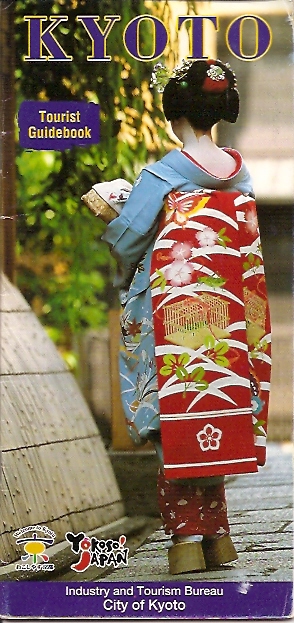
…a bright cobalt blue contrasting with a traffic light red, with secondary use of white and gold, plus green. In terms of motifs, the blue seems to contain autumn maple leaves, while the red obi obviously contains butterfly, cricket, cricket cage, etc. Such a strong duality of this red with this blue is not as common as the red/green complimentaries, while the trio of red-white-blue is no stranger to any of us.
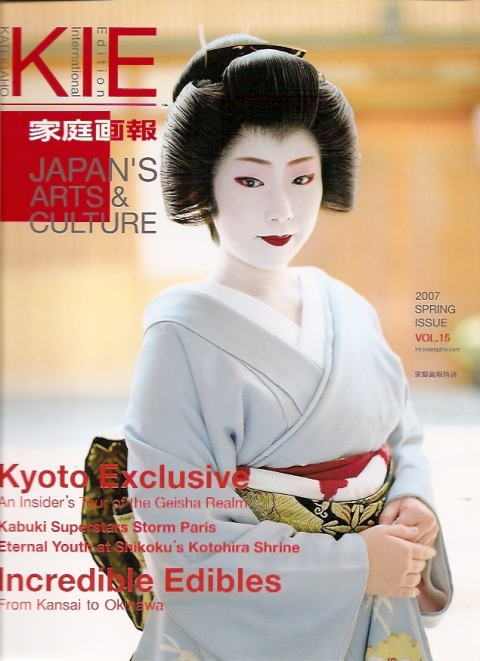
Similarly, this KIE magazine issue, hanging around since some previous posts on kanzashi and Kyoto, has a similar use of blue and red, with mediating black and gold (at least from this angle – stricly speaking, the overall effect is pale sky blue with black/gold if we consider just kimono and obi). The use of (obviously) hand-dyed red in the obiage behind the obi is very striking, and obviously imitates the facial makeup. I suspect there is some shibori used in the far right corner of this obiage – shibori always having a close relationship with obiage.
So, with this blue/red color combination in mind, I consulted my ‘bible’ in matters to do with Japanese colour combinations:

… in Hideaki Chijiiwa’s Color harmony, I find it is a combination used in traditional Japanese textiles. This is not surprising, when we consider the use of blue from ai indigo (pale colours indicating not many dips into the dye) and red from the traditional dye-source, benibana, known for its fugitive behaviour.
So, I set about using these colours in a temari of intermediate grade difficulty I’ve been meaning to make for some time. It’s in Ozaki’s Elegant Temari (ISBN 4837706959) and is done in red and white on a black mari: page 26, bottom pattern. I wrapped a sky blue mari and put in a simple 8 division in gold metallic thread. Followed by two overlapping squares 3cm from the poles. At this point, I need to say that the ball was exactly 23cm as per the pattern: interestingly, the pattern didn’t call for direct geometric divisions, e.g. a half, or a third of any set distance, but prescribed distances in centimetres. So in these cases, I follow the pattern and work out any ways of enlarging the pattern for larger balls later on.
Now the order of stitching is not exactly clear from the pattern, so with some experimentation and ripping out stitching as I went, I ended up doing a set of four ‘kite’ patterns and then doing the next four interlocking over and under the first (that is, do those labelled A then those labelled B). My first mistake was not to interlock the kites, so I had one lot completely overlapping the other… doh! During the ripping out process, I changed my colours from bright white and traffic-light red, to a darker crimson and a two shades of blue. This immediately made the whole thing a lot more tranquil – I have to say the red/white/black of the original has been putting me off for ages with its over-the-top striking quality! – but inevitably the crimson moves towards the blue becoming somewhat purple at a distance.
Unfortunately with a ball as small as 23cm circumference, every measurement counts, so tolerances for errors have to be extremely small. This is also a good exercise in keeping stitches parallel to jiwari guidelines, because they have to meet up at the ‘seams’ of the guidelines. Ultimately, I veered from my original intention somewhat in not having so strong a white contrast.
Picture to follow!
Retailing kimono in contemporary Japan
July 19, 2009

Warehouse shops like these sell kimono; this one is tucked away in Izumisano, in suburban Osaka.
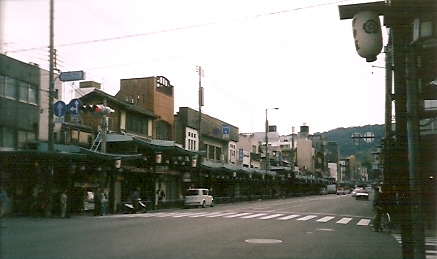
I mentioned previously Shijo-dori or Shijo Street, one of the main roads in the Gion quarter of Kyoto. Here it is very early on a dull November day – long before trading starts, looking from the river end towards one of the entrances to Maruyama Park, In the middle of this photo, beyond the white parked car, are the three or four kimono accessory shops mentioned previously. So this amounts to the high-end kimono accessory retailing channel: obijime, kanzashi, etc.
Anime manga: Border Crossings panel discussion
July 18, 2009
Border Crossings: intersections between Japanese popular culture and fandom. Anime panel discussion. Friday 17 July 2009, University of Sydney.
Roland Kelts (USA); Susan Napier (USA); Dean Prenc (AUS); Amanda Setiadi (AUS); Dr Rebecca Suter Univ Syd, moderator.
Nobuhito Hobo, Consul-General of Japan in Sydney, gave a great overview of post-WW 2 popular culture, mentioning the birth of boys’ and girls’ comics in 1959 against the backdrop of a sudden rise in economic affluence. “Border crossings” were happening even then with Tezuka’s Leo and Disney’s Kimba the White Lion, later ‘crossing’ back to Disney’s Lion King in 1994; the Australian connection with Felix the Cat also got a guernsey. I’m glad Edo Period popular culture forms, cho-min bunka – kabuki, joruri, ukiyoe, kibyoshi and rakugo – were introduced by way of tradition and innovation within Japan, not only because they were popular forms of culture at the time, as opposed to much traditional culture which falls out of the ruling elites, but because modern culture needs to be grounded in historic predecessors. Hobo-san also discussed the ‘pro-sumer’, apparently predicted as early as 1980, where the ‘consumer’ becomes or can become ‘producer’.
Roland Kelts drew from his latest book, Japanamerica: how Japanese pop culture has invaded the US, to give us very valuable insights into the border crossings between Japan and that country. He reminded us of the length of time involved in US occupation of Japan post-war, 1945 right through to 1952, as well as Tezuka’s love for Disney’s Bambi and a need to make kinetic ukiyo-e. The Japanese interest in the darker and wilder compared to the US was touched on, exemplified in part by Tezuka’s interest in very serious subjects (Crime and Punishment). Kelts many times mentioned the cultural specificity of Japan: the permeability involved in private and public life, anime manga as essentially underground and far from mainstream. He reminded us of the importance of minimalism (Murakami’s ‘super-flat’) compared to the US depictions which, being representational and naturalistic, limit the imagination a great deal more than in Japan. I really appreciated talk about depth of field, perspective and contour (especially in relation to Pokemon) as someone who likes drawing parallels between cartoon art and traditional cropping/breaking the frame/pattern/figuration in Japanese art, craft and textiles. Later, in response to questions from the audience, he provided valuable feedback on issues relating to censorship and sexual depiction; hybridisation (the Afro-samurai); American anime manga based on the Japanese but having to be recast by the Japanese for the Japanese market (!); the current financial crisis, the ageing of the otaku audience and the artist/audience loop involved (compared to a diminished younger audience, thanks to the birthrate) .
The innate interactivity within Japanese culture (the lack of an artist/audience divide in tea ceremony, ikebana, karaoke) is the foundation for modern fandom phenomena – “experiencing the dream world” was an important phrase, full of resonance. Napier discussed the various manifestations of power at work in anime manga: soft cultural power (for example, which resonates well with Australian culture where I’m reminded of the observation that Australian soldiers could be very easily led by their superior officers if the superiour showed vision and used charisma, but that the troops were highly resistant to being led by offices who simply bullied or coerced them); otakudom and fandom’s manifestations – the importance of transformation and metamorphosis (and by inference catharsis perhaps). As well as discussing the films of Miyazaki, the common denominator of a lot of the night’s discussion, she mentioned Wall-e (Pixar) as a Japanified American creation.
At various intervals during the evening, the global financial crisis in Japan was raised (Depression, by any other name, surely): anime manga as so strongly linked to affluence, the low incomes of workers in the industry, the Mom-and-Pop owner-creators, outsourcing to Chinese studios, developments elsewhere in Korea, Taiwan, China, etc.
Prenc and Setiadi provided the necessary detail for Australian perspectives, relating to local distribution and manifestations of fandom respectively. The description of Madman’s expansion and its close relationship to its customer base, particularly in catering to the ‘amateur’ interests of its fan and consumer base was very valuable. The social or ‘mass public’ elements (via conventions, cosplay performance, theatrical distribution and ‘cinema events’ – a Japanified form of the midnight performances of Rocky Horror Show, etc.) compare interestingly with the private and solitary, e.g. fan fiction, borrowing/glossing from original literary (manga) texts, artwork, etc.).
As a result of this event, I personally look forward to more academic discourse, as well as observing fandom in action, at local events in the coming months.
Kimono accessories in contemporary Japan
July 15, 2009
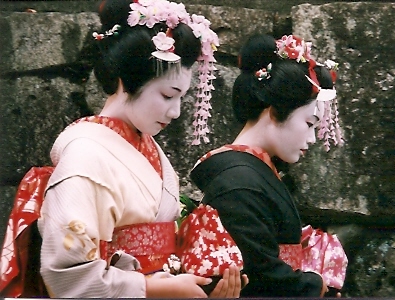
Sakura (cherry blossom) hana-kanzashi hair ornaments – silk flowers formed with tweezers and fingers.
If you’ve been noting my previous photos of kimono-wearing women in modern day Japan, you may have noticed hair accessories. In particular:
* the complete lack of any hair accessories in everyday wearing of kimono (e.g. my photo of visitors to Toji Market and Kiyomizudera)
* the subtle single ornament as used by models in the kimono fashion shows at Nishijin Textile Centre, and
* the very elaborate traditional hana-kanzashi or silk flower ornaments, as worn by maiko, geiko and geisha.
I don’t own any hair ornaments myself, otherwise I’d photograph and upload here, but I’m sure there are plenty of photos of kanzashi and hana-kanzashi available on the internet.
My ready-reference for such things is my copy of Kateigaho International magazine, no.15 Spring 2007. For those of you not familiar with KEI, it’s a 160page quarterly glossy magazine in English (hence the International edition). When I say, glossy, I mean extravagantly glossy – complete with full-page ads for the top names in fashion. They direct readers to high-class Tokyo boutiques and restaurants, but the magazines are an invaluable source of information about living artist-craftspeople maintaining traditions in modern-day Japan. Check your nearest Japanese bookshop, such as Kinokinuya, and http://int.kateigaho.com
No.15 has a ‘special’ on Kyoto, including articles on traditional boxwood combs and geisha hairstyles and hairstylists. The hana-kanzashi are made from 500+ 2cm squares of fine silk gauze by the fifth-generation maker at Kintakedo in Gion, Kyoto. This particular shop is among three or four such shops in the middle of Shijo-dori street, Gion – one of which sells high-class obijime. I’ve mentioned tortoise-shell combs/pins previously, as made in a traditional crafts enclave in Tokyo.
Kimono in contemporary Japan
July 14, 2009
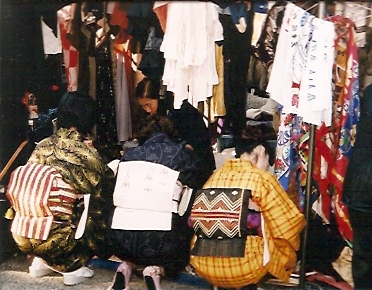
Kimono are rarely sighted in today’s Japan. So much so, that Japanese will whip out their mobile phones to take a picture of someone in traditional clothing in public. The scene above however excited no such cellphone activity because it was the First Sunday of the month in Kyoto, which is the antiques market at Toji Temple. This is a much smaller flea market than the better-known Kobo-san market on the 21st of each month held at the same temple. The antiques market is limited to vintage textiles, metalwork, ceramics. I found a second-hand dealer in obijime and another in sakiori. Some had odd pieces of shibori and katazome.
And there were a few dealers in second-hand kimono. A group of three young women were out, dressed in kimono, and stopped by at one stall. They decided to stay a while, so sat down to more carefully go through the kimono. Of course of interest to us is the unpretentious, everyday nature of the kimono patterns and the ordinary, everyday shoes – we’re talking young women who are learning about traditional culture and decide to dress up to visit the market. Some young Japanese women these days are fascinated by the culture of their elders and are ‘experimenting’ with the old garments, and finding opportunities to wear them – most often in the context of the ‘old culture’.
Which brings me to the point of today’s post – I can only really think of five or six specific contexts in which women will be spotted wearing kimono around in public in contemporary Japan these days.
1. Weddings, graduations and other formal family occasions, such as important temple-visiting at the time of important rite-of-passage festivals, for example when young children turn the right age (3,5,7 years of age) to participate in the Shichigosan festival in November.
2. Those working the catering and hospitality industries, or in retail where the product is traditional.
3. Attending important cultural events. Older women will dress in kimono as a mark of respect (and enthusiasm) especially if they are going off together in a group tour of something like the exhibition of Shosoin Treasury collection items in Nara.
4. Attending tea ceremony classes or traditional singing group meetings. I came upon such an tea institute in Osaka, with women coming and going in kimono, as well as a large gathering of amateur singers at the Osaka Town Hall, obviously rehearsing for some upcoming concert or other. Women will attend kimono classes where they learn to tie obi and attend properly to the myriad of details associated with putting on kimono. Bookshops will feature how-to magazines such as the one below:
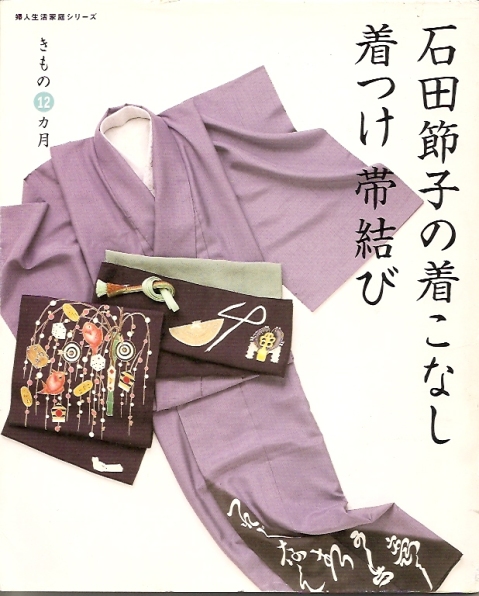
Such magazines are great reading for anyone interested in colour combinations, pattern combinations, obijime designs and so on.
5. Those in the geisha industry. It’s unlikely you’ll see geisha except very briefly in Gion at night-time, the entertainment quarter of Kyoto, but maiko apprentices travelling to morning music classes can sometimes be spotted in Kyoto. Here are two maiko spotted at ten o’clock in the morning near Kiyomizu-dera. Interestingly, they braved the public domain without a chaperone – stopping for photos (mainly by Japanese domestic tourists, let alone any foreigners around) means the poor girls may be late for their appointment, so they often have another woman in tow just to ensure they keep ‘moving’. Woe betide any maiko who stops more than briefly for photos – otherwise she will quickly gather around her a crowd of photo-snappers! These two below were pretty much oblivious to photographers, probably because they were busy negotiating some stone steps…
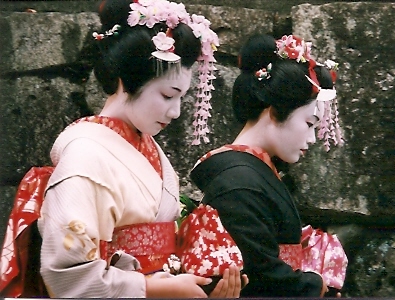
The elaborate silk flowers that go to make up the hair ornaments are obvious in this shot. I have yet to visit the small museum in Gion, Kyoto, devoted entirely to geisha wigs and hair ornaments.
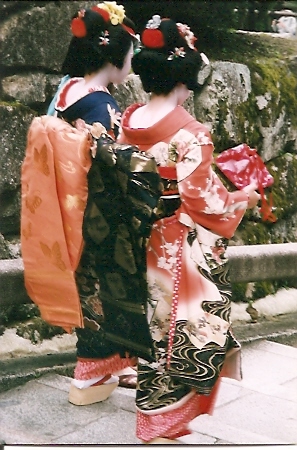
And what marks this pair off as real maiko, apart from the elaborately-tied obi (notice the butterflies on the one on the left) are the geta – the traditional shoes. How they negotiated steps I have no idea, but their height is useful in keeping the kimono out of puddles. I was surprised to see a man in such shoes once, outside a small eatery – he was obviously a chef or cook – and plainly the height of the shoes meant he could negotiate wet floors. I draw your attention to the traditional makeup, especially around the nape of the neck. Obvious also is the use of red and bright colours which women can only wear at a certain time in their lives – wearing such colours after marriage or over the age of 25 or so would be unthinkable.
Which brings me to the last category I can think of for the moment…
6. domestic Japanese tourists (and foreigners) who want to undergo the Textile Tourist experience of getting dressed up in traditional kimono and (if they dare) walking around the block in public so dressed and made-up. One sees such experiences advertised in the tourist literature of Kyoto, but I happened upon it in real-life in Gion… I spotted what looked like a maiko from afar, but on getting closer, realised it wasn’t actually the ‘real thing’. The women involved were having a great time, photographing each other in the back streets of Gion, some of which have been restored to former glory (notwithstanding the ubiquitous power poles).
On the subject of shoes, I’ll dig up some photos of dancing in similar shoes – photos taken of a dancing troupe from Japan visiting Sydney as part of the Japanese community’s mid-summer public event. The idea of wearing geta is one thing – dancing in them, another!
Japan (3) – Legless in Ginza
July 9, 2009
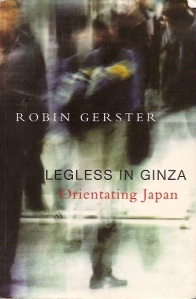
Robin Gerster, Legless in Ginza: orientating Japan. Melbourne, Melbourne University Press, 1999.
Chp.1 Into the Inferno (Todai-Tokyo University). Chp.2 Riding Santa’s Surfboard (Australian Studies in Japan). Chp.3. Fault Lines (Australians writing on Japan). Chp.4: The Big Smoke (Edo); Chp.5. Out of Edo I (Hokkaido); Chp.6. Out of Edo II (Unzen, Nikko, Hiroshima, Kyoto); Chp.7 Boomerang Japan.
I dip into this book at regular intervals. Like most books written about Japan (and who can’t not write about Japan and the Japan experience) it reads like a Japanese scroll – you open it up at wherever and read to wherever. I personally find the bouncy tone a little grating here and there. I can see what he’s doing with his teaching colleagues he describes in his Tokyo University post, since the authorial presence peeps through only occasionally. There is something of the retreat from the real world in this common room and its occupants, the dualism that is characteristic also of the film Lost in Translation.
It is ultimately a book of its time, the high times of Tokyo pre-bubble, and to his credit, Gerster is very even-handed, for example in his interest on San’ya in Tokyo, alongside Ginza. Having witnessed first-hand the homelessness in Osaka, I can begin to appreciate what’s he writing about – the contrast of a man sleeping in a large cardboard box amid a forest of skyscrapers.
I found his descriptions of Tokyo extremely interesting, as also his sojourn to Hokkaido for a complete change of scene – a Hokkaido before the onset of Australian skiing entrepreneurs. Having neither been to either, I approach them via Osaka and Kyoto, but get a full flavour-burst of them: a bit like an enthusiastic concert reviewer reviewing a concert you have yet to attend. The struggle between Kyoto and Tokyo in the modern era comes up again and again, here as in Kerr’s Lost Japan. Whether or not prompted by Kerr, I certainly felt it in Kyoto when either observing the heavy-lidded world-weary establishment Kyotoites (with their bowing bordering on being almost a religious experience) and visiting Tokyoites thoroughly exasperated by the veils of indecisiveness of the Kyoto locals.
I am in total agreement with Gerster about the significance for example of train travel in Japan; in this regard, I am always struck by the poignant use in trains and subway carriages in Miyazaki’s Spirited Away every time I watch it.
He appears to get most personal when discussing Hiroshima, but what I found most illuminating was his quite detailed and thorough examination of Australian writing about Japan from the earliest impressions down to the present. I will certainly keep coming back to this and the issue of perceptions of Japan by Australians and by the Japanese of Australia he discusses. I am certainly motivated to go to the various authors mentioned for more insights.
This book makes a great change from reading some of the much earlier Australian authors on Japan, mainly I guess because the information is more current and meaningful – where the War seems to have less of a long shadow – , though Japan has moved into the very protracted post-1990s era of dourness from my experience. I certainly appreciate the underlay of dry Australian humour throughout. Probably not ideal for an American audience (though he loses no opportunity to bring Americans into the fold), but a thoroughly excellent read for any interested Australian.
Indonesia (1) : On cultural expression
July 9, 2009

It’s de rigeur in weblogging to pepper text with photos. It’s a sign of the times; in days of yore, prose was strong enough to stand on its own two feet. These days, one needs a graphic. A decade or two ago, I would have equated this to a variation on primary-school student activity, but days, it’s as I say de rigeur and there’s no escaping!
So I’m playing the game, but also turning the conceit on its head. Today’s photo is telling because of what it doesn’t say, as much as what it does say about cultural expression in Islamic Indonesia. The book is titled “Islamic Art”, there’s not a single mention of Indonesia. It’s as if Indonesia didn’t exist. I’m not critical of the author or the publisher – it was published in 1975 -, but it speaks volumes about the difficulty of coming to grips with the notion of cultural expression in Indonesia, a significant part of which is Islamic. If titled “Arabic Art” I could understand why the world it describes stops at Iran. I’m struggling with the implications of ‘cultural expression in contemporary Islamic Indonesia’ and this book exemplifies I guess that struggle.
So what is “cultural expression”? I’m familiar with aesthetics, culture, cultural heritage and cultural hybridity, but cultural expression is a curious turn of phrase. It certainly sounds all-encompassing and obviously includes the arts, but could it – in an Indonesian and/or Malaysian context – go beyond the visual and performance arts – to women in advertising, newspapers and media, the internet? Far beyond art-as-artefact, art practice and museums: the creation, fashioning and retention of cultural objects? Far beyond, perhaps, just literature and cinema?
In a Japanese context, moving beyond literature and cinema seems superficially easier: matsuri, manga, tea ceremony, geisha. Beyond the artefacts associated with traditional music, theatre and opera, textiles, ceramics, paper and ink. Even manga can be broken down to include still cartoons (and movie stills), films, text-only prose, graphic novel/cartoon books, cosplay, memorabilia, manga events and even ‘additional’ texts (prequels, sequels and taking characters out of their original and constructing new stories by new authors).
In a Chinese context, there is literature, cinema and architecture, thanks to the Olympics. Plus the diaspora of painters.
Can one legitimately extend ‘cultural expression’ (a term which seems often to be used in an Indonesian sense, crowded with Dutch connotations) be extended to advertising, journalism, tourism and food? Do we include religious observance and ritual, religious preaching, mass political movements and their dynamics? To what extent is Indonesian cultural expression an extension of Javanese culture and the power of Java in the modern Indonesian state, in contrast to cultures (and traditional/modern cultural expression) in islands other than Java? For most Australians, ‘Indonesian cultural expression’ is synonymous with Bali. Yet nothing could be greater in terms of history, art, religion and ‘contemporary society’ than the differences between Bali and Java, or Bali and the rest of Indonesia. As a Westerner visiting Java, I have to admit to having been more interested in the museum ceramics and night folk theatre of Jakarta, even Taman Mini, than interrogating Islamic Indonesia. More interested in Borobudur and the Jogjakarta imperial court. Similarly, in his recent television documentary on gardens around the world for the BBC, Monty Don visited Bali to investigate both the traditional garden styles as well as the ‘applied’ contemporary notion of the ‘tropical’ or Balinese garden.
Japan (2) – Lost Japan
July 9, 2009

Alex Kerr, Lost Japan. Melbourne, Lonely Planet, 1996. Lonely Planet Journeys series. ISBN 0864423705.
Absolutely essential reading for anyone travelling to Japan. A highly recommended study of the mix of traditional and modern that makes up contemporaryJapan, from the perspective of a foreigner deeply embedded in traditional Japan. Every time I dip into it – and I’ve read the chapters on Osaka, Kyoto and Nara dozens of times – I find something new and surprising.
This is not just a readable bunch of essays devoted to kabuki, calligraphy, ink painting and traditional cultural centres Kyoto and Nara. It is essential reading both before and after visiting Osaka, Kyoto, Nara and the Yamato Plain. Kerr describes his foray into traditional architecture in Shikoku, far off the beaten track. His deep affection for kabuki and sumi is infectious and his descriptions of Kyoto and Nara are uncanny in their perceptiveness: the forests of Fushimi-Inari, the borrowed landscape at Ryoanji, Byodoin, the temple gate sculptures at Nara.
Japan (1) – On the Cultural Supermarket
July 9, 2009

Gordon Mathews, Global culture/individual identity: searching for home in the cultural supermarket. Routledge, 2000. ISBN 0415206162.
Absolutely essential reading for anyone involved in Japanese art/craft, especially those operating outside Japan. HIghly recommended for anyone travelling in Japan for the purposes of pursuing traditional Japanese culture.
Though the book also covers America and China, of particular interest are the first 75 pages devoted to Japan, plus the concluding 33 pages.
Chapter 1 talks about culture in general and cultural identity; how, these days, it is linked to nation-states in a world more interested in globalisation. The idea of a cultural supermarket is posited – individuals around the world constantly ‘going shopping’ and the identity issues associated with a smorgasbord apporach to culture both in everyday life and in the special vocational calling associated with traditional art/craft.
Chapter 2 sums up anthropological fieldwork interviews with dozens of Japanese practitioners working in the traditional art/crafts in Japan. Interestingly, they all seem to be born before 1950 and there’s no discussion for example of the traditional lifestyle ‘boot camp’ experiences for young people these days on Sado Island in the training of the next generation of taiko dummers. Nor the rigours associated with the young these days entering the world of geisha or entering the closed communities of sumo wrestler stables.
For any Westerner visiting or staying in Japan, coming to grips with the Westerness of Japan is one thing, but there are other equally important concepts to be grasped and appreciated: the discourse on being Japanese (nihonjinron), traditional apprenticeship in the arts (iemoto seido), operating in Tokyo and outside Tokyo, operating as a ‘Western’ artist in Japan and as a ‘Japanese’ artist in Japan. All are lucidly and brilliantly described.
Of particular interest to me are the implications for textile study, especially the very great divide between kimono/silk/urban/middle-class and the bast fibres/country/working poor, beyond the cultural (global) stereotypes surrounding kimono/geisha/Kyoto. Outside the scope of this study are the impacts of the internet (written in 2000) and how art/craft exponents born post-World War II tackle issues sch as fluency in English and overseas travel and teaching as part of their lifestyle. The transfer of skills from Japanese to non-Japanese is hinted at in the discussion of the huge numbers of foreign shakuhachi students living in Tokyo at any one time. Obviously the iemoto seido is largely a thing of the past (young apprentices are these days more likely to be middle-aged women attending kimono-wearing or craft classes) and the model simply doesn’t function as it traditionally did with foreign ‘apprentices’ living and working overseas. References to the influence of traditional Chinese culture are particularly pertinent given the importance of the Shoso-in collection and the ways in which the Japanese have come to transcend Chinese textiles and made Japanese textiles truly Japanese. The barriers artists come across are not dissimilar to products withdrawn from sale or ‘discontinued lines’ in the supermarket paradigm: I think of the adaptation required to work in plastic resin, used in the carving of traditional ornaments and hair combs from tortoise-shell, a material no longer available in the wild but a product of aqua-farming. I’m also struck by the use of synthetic substitutes in the modern ‘supermarket’ (as opposed to the ‘corner store’): silk replaced by silk substitutes, the machine-made so good it looks indistinguishable from the handmade, synthetic dyes replacing natural indigo, the outsourcing of things Japanese to China.